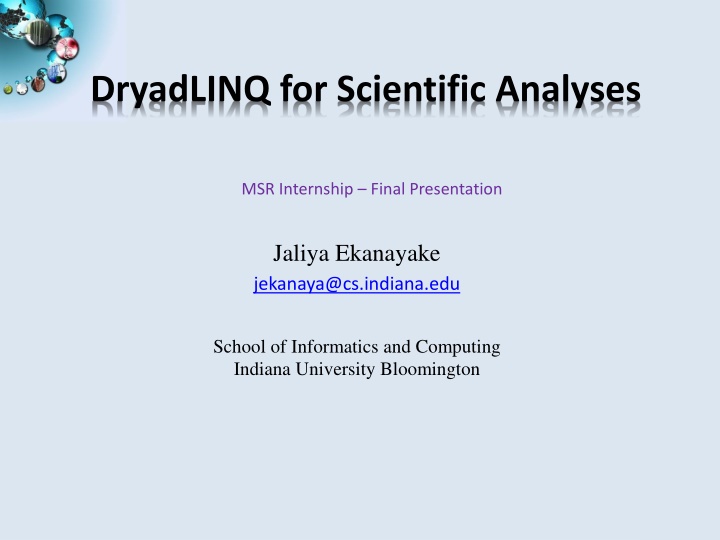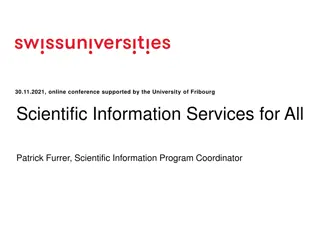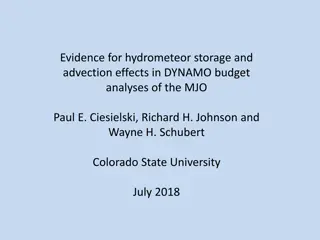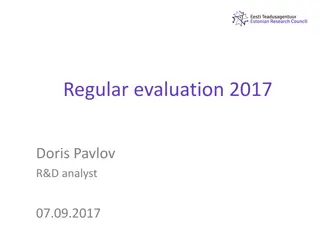Evaluation of DryadLINQ for Scientific Analyses
DryadLINQ was evaluated for scientific analyses in the context of developing and comparing various scientific applications with similar MapReduce implementations. The study aimed to assess the usability of DryadLINQ, create scientific applications utilizing it, and analyze their performance against other frameworks such as Hadoop. The applications covered a range of fields including cryptography, high-energy physics, clustering, and more. The comparison highlighted the differences in parallel runtimes, programming models, data handling, and monitoring support between DryadLINQ and Hadoop.
Download Presentation

Please find below an Image/Link to download the presentation.
The content on the website is provided AS IS for your information and personal use only. It may not be sold, licensed, or shared on other websites without obtaining consent from the author.If you encounter any issues during the download, it is possible that the publisher has removed the file from their server.
You are allowed to download the files provided on this website for personal or commercial use, subject to the condition that they are used lawfully. All files are the property of their respective owners.
The content on the website is provided AS IS for your information and personal use only. It may not be sold, licensed, or shared on other websites without obtaining consent from the author.
E N D
Presentation Transcript
DryadLINQ for Scientific Analyses MSR Internship Final Presentation Jaliya Ekanayake jekanaya@cs.indiana.edu School of Informatics and Computing Indiana University Bloomington SALSA SALSA
Acknowledgements to ARTS Team Nelson Araujo (my mentor) Christophe Poulain Roger Barga Tim Chou Dryad Team at Silicon Valley School of Informatics and Computing, Indiana University Prof. Geoffrey Fox (my advisor) Thilina Gunarathne Scott Beason Xiaohong Qiu SALSA
Goals Evaluate the usability of DryadLINQ for scientific analyses Develop a series of scientific applications using DryadLINQ Compare them with similar MapReduce implementations (E.g. Hadoop) Run above DryadLINQ applications on Cloud SALSA
Applications & Different Interconnection Patterns Map Only MapReduce Iterations Tightly synchronized (MPI) iterations Input map Input Input map map Pij reduce Output reduce CAP3 Analysis Document conversion (PDF -> HTML) Brute force searches in cryptography Parametric sweeps High Energy Physics (HEP) Histogramming operation Distributed search Distributed sorting Information retrieval Expectation maximization algorithms Clustering Matrix multiplication Many MPI applications utilizing wide variety of communication constructs CAP3 Gene Assembly HEP Data Analysis CloudBurst Tera-Sort Calculation of Pairwise Distances for ALU Sequences Kmeans Clustering Kmeans Clustering Calculation of Pairwise Distances for ALU Sequences SALSA
Parallel Runtimes DryadLINQ vs. Hadoop Feature Dryad/DryadLINQ Hadoop Programming Model & Language Support DAG based execution flows. Programmable via C# DryadLINQ Provides LINQ programming API for Dryad MapReduce Implemented using Java Other languages are supported via Hadoop Streaming Data Handling Shared directories/ Local disks HDFS Intermediate Data Communication Files/TCP pipes/ Shared memory FIFO HDFS/ Point-to-point via HTTP Data locality/ Rack aware Scheduling Data locality/ Network topology based run time graph optimizations Failure Handling Re-execution of vertices Persistence via HDFS Re-execution of map and reduce tasks Monitoring Monitoring support for execution graphs Monitoring support of HDFS, and MapReduce computations SALSA
Cluster Configurations Feature GCB-K18 @ MSR iDataplex @ IU Tempest @ IU CPU Intel Xeon CPU L5420 2.50GHz Intel Xeon CPU L5420 2.50GHz Intel Xeon CPU E7450 2.40GHz # CPU /# Cores 2 / 8 2 / 8 4 / 24 Memory 16 GB 32GB 48GB # Disks 2 1 2 Network Giga bit Ethernet Giga bit Ethernet Giga bit Ethernet / 20 Gbps Infiniband Operating System Windows Server Enterprise - 64 bit Red Hat Enterprise Linux Server -64 bit Windows Server Enterprise - 64 bit # Nodes Used 32 32 32 Total CPU Cores Used 256 256 768 DryadLINQ Hadoop / MPI DryadLINQ / MPI SALSA
CAP3 - DNA Sequence Assembly Program [1] EST (Expressed Sequence Tag) corresponds to messenger RNAs (mRNAs) transcribed from the genes residing on chromosomes. Each individual EST sequence represents a fragment of mRNA, and the EST assembly aims to re-construct full-length mRNA sequences for each expressed gene. GCB-K18-N01 Input files (FASTA) \DryadData\cap3\cap3data 10 0,344,CGB-K18-N01 1,344,CGB-K18-N01 9,344,CGB-K18-N01 Cap3data.pf V V Cap3data.00000000 \\GCB-K18-N01\DryadData\cap3\cluster34442.fsa \\GCB-K18-N01\DryadData\cap3\cluster34443.fsa ... \\GCB-K18-N01\DryadData\cap3\cluster34467.fsa Output files Input files (FASTA) IQueryable<LineRecord> inputFiles=PartitionedTable.Get <LineRecord>(uri); IQueryable<OutputInfo> = inputFiles.Select(x=>ExecuteCAP3(x.line)); SALSA [1] X. Huang, A. Madan, CAP3: A DNA Sequence Assembly Program, Genome Research, vol. 9, no. 9, pp. 868-877, 1999.
CAP3 - Performance SALSA
It was not so straight forward though Two issues (not) related to DryadLINQ Scheduling at PLINQ Performance of Threads Skew in input data Fluctuating 12.5-100% utilization of CPU cores Sustained 100% utilization of CPU cores SALSA
Scheduling of Tasks DryadLINQ Job Partitions /vertices DryadLINQ schedules Partitions to nodes Hadoop Schedules map/reduce tasks directly to CPU cores 1 PLINQ explores Further parallelism PLINQ sub tasks 2 Threads Threads map PLINQ Tasks to CPU cores 3 CPU cores 1 Problem 4 CPU cores 4 CPU cores Partitions 1 2 3 Time Partitions 1 2 3 Time Better utilization when tasks are homogenous Under utilization when tasks are non-homogenous SALSA
Scheduling of Tasks contd.. 2 Problem PLINQ Scheduler and coarse grained tasks E.g. A data partition contains 16 records, 8 CPU cores in a node We expect the scheduling of tasks to be as follows 8 CPU cores X-ray tool shows this -> 100% 50% 50% utilization of CPU cores Heuristics at PLINQ (version 3.5) scheduler does not seem to work well for coarse grained tasks Workaround Use Apply instead of Select Apply allows iterating over the complete partition ( Select allows accessing a single element only) Use multi-threaded program inside Apply (Ugly solution) Bypass PLINQ 3 Problem Discussed Later SALSA
Heterogeneity in Data 2 partitions per node 1 partition per node Two CAP3 tests on Tempest cluster Long running tasks takes roughly 40% of time Scheduling of the next partition getting delayed due to the long running tasks Low utilization SALSA
High Energy Physics Data Analysis Histogramming of events from a large (up to 1TB) data set Data analysis requires ROOT framework (ROOT Interpreted Scripts) Performance depends on disk access speeds Hadoop implementation uses a shared parallel file system (Lustre) ROOT scripts cannot access data from HDFS On demand data movement has significant overhead Dryad stores data in local disks Better performance SALSA
Kmeans Clustering Time for 20 iterations Iteratively refining operation New maps/reducers/vertices in every iteration File system based communication Loop unrolling in DryadLINQ provide better performance The overheads are extremely large compared to MPI Large Overheads SALSA
Pairwise Distances ALU Sequencing 125 million distances 4 hours & 46 minutes Calculate pairwise distances for a collection of genes (used for clustering, MDS) O(N^2) effect Fine grained tasks in MPI Coarse grained tasks in DryadLINQ Performance close to MPI Performed on 768 cores (Tempest Cluster) 20000 DryadLINQ 18000 16000 MPI 14000 12000 10000 8000 6000 Processes work better than threads when used inside vertices 70% utilization vs. 100% 4000 3 Problem 2000 0 35339 50000 SALSA
Questions? SALSA
DryadLINQ on Cloud HPC release of DryadLINQ requires Windows Server 2008 Amazon does not provide this VM yet Used GoGrid cloud provider Before Running Applications Create VM image with necessary software E.g. NET framework Deploy a collection of images (one by one a feature of GoGrid) Configure IP addresses (requires login to individual nodes) Configure an HPC cluster Install DryadLINQ Copying data from cloud storage We configured a 32 node virtual cluster in GoGrid SALSA
DryadLINQ on Cloud contd.. CAP3 works on cloud Used 32 CPU cores 100% utilization of virtual CPU cores 3 times more time in cloud than the bare- metal runs CloudBurst and Kmeans did not run on cloud VMs were crashing/freezing even at data partitioning Communication and data accessing simply freeze VMs VMs become unreachable We expect some communication overhead, but the above observations are more GoGrid related than to Cloud SALSA
Conclusions Six applications with various computation, communication, and data access requirements All DryadLINQ applications work, and in many cases perform better than Hadoop We can definitely use DryadLINQ for scientific analyses We did not implement (find) Applications that can only be implemented using DryadLINQ but not with typical MapReduce Current release of DryadLINQ has some performance limitations DryadLINQ hides many aspects of parallel computing from user Coding is much simpler in DryadLINQ than Hadoop (provided that the performance issues are fixed) More simplicity comes with less control and sometimes it is hard to fine-tune We showed that it is possible to run DryadLINQ on Cloud SALSA
Thank You! SALSA SALSA























